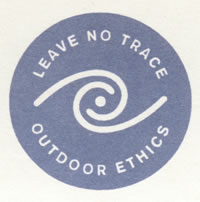On your last wilderness
trip, did discarded cigarette butts, scarred trees, or trash-filled
fire rings spoil the view? Did pieces of toilet paper--or
possibly even unburied feces--compel you to pass up an otherwise
pristine spot?
If so, make sure you're not unknowingly
contributing to the problem. Always practice low-impact, leave-no-trace
techniques when in the wilderness. By adhering to some relatively
simply guidelines, you'll be able to preserve the wilderness
experience for the generations of trekkers who'll follow in
your footsteps.
Cans, bottles, aluminum foil, and other
non-burnable items should always be packed out. Don't bury
them or leave them in a fire ring. Try to leave an area cleaner
and neater than you found it. Pack out any trash you see.
Avoid scarring trees with nails or "constructing"
rustic camp furniture. Don't cut standing trees or browse.
Avoid "trenching" around your tent. Artifacts, plants,
trees, and rocks should remain undisturbed. Avoid marking
your route with blazes, surveyor's tape, or fluorescent tacks.
Human feces, pet waste, toilet paper, and
soapy wash water should be buried in a six-inch-deep cat hole
dug 200 feet (or 75 right-foot paces) away from campsites,
trails, water sources, and any area likely to be visited by
others. To further reduce your impact on the environment,
use biodegradable toilet paper like the RV-type available
from Wal-Mart, K-Mart, and other camping outlets. Avoid burning
toilet paper in snow-free areas as many a disastrous fire
has been started this way.
Keep in mind that sand, leaves, and pine
needles are great, natural alternatives to soap for all but
the greasy pot. If you absolutely must use soap, use a small
amount of biodegradable soap and avoid the temptation to rinse
off in a river or lake. Instead, rinse off with water from
your cooking pot and water bottles well back from shore. If
you're looking for a great selection of biodegradable soaps,
contact REI at 1-800-426-4840, or point your Internet browser
to http://www.rei.com.
To avoid scarring rocks, depleting wood
resources, and creating unsightly charred areas, carry a lightweight
backpacking stove. In the evening, try socializing around
a candle lantern or two instead of a campfire.
If you decide to build a fire, protect
the ground from scarring by laying down a six-inch-thick layer
of sand or mud. Keep the fire small, and burn every piece
of wood completely so unsightly charred logs are not left
behind.
Always extinguish your fire so that after
stirring, the coals are cool to the touch. Next, pulverize
the coals into a fine ash and broad-scatter them where they're
not likely to be spotted by others. To ensure that you leave
no trace of your fire, return the protective layer of sand
or mud to its original location.
By adhering to these simple, low-impact,
leave-no-trace techniques, you can help keep the "wild"
in your favorite wilderness.
See you in the bush.
Leave No Trace, Inc.
http://www.lnt.org
1-800-332-4100
A treasure trove of information
Leave No Trace--Outdoor Ethics &
Skills for Outdoor Users, by Chris Conway
http://www.backcountryattitude.com/leave_no_trace.html
Outdoor Activities Guide to Leave No
Trace Camping Resources, by Rick Curtis
http://www.princeton.edu/~oa/lnt/index.shtml
Principles of Leave No Trace for outdoor
adventures, by Boy Scouts of America
http://www.bsa.scouting.org/boyscouts/resources/21-105/
Tread Lightly
http://www.treadlightly.org/
Wilderness Manners, by the Sierra
Club
http://www.sierraclub.org/outings/national/wilderness.asp
(or search "Wilderness Manners"
at http://www.sierraclub.org)
Backwoods Ethics--Environmental Issues
for Hikers and Campers, 2nd edition, revised, by Laura
Waterman and Guy Waterman (Countryman Press, 1993). A very
well-written, insightful, and thought-provoking book.
Basic Essentials of Minimizing Impact
on the Wilderness, by Michael Hodgson (ICS Books,
Inc., 1991)
How to Build a Better Outdoors,
by Bill Vogt (David McKay, 1978)
How to Shit in the Woods--An Environmentally
Sound Approach to a Lost Art, by Kathleen Meyer (Ten
Speed Press, 1994)
Leave No Trace--A Practical Guide
to the New Wilderness Etiquette, by Annette McGivney
(The Mountaineers, 1998)
Leave No Trace!--An Outdoor Ethic,
pamphlet FS-520 (USFS, 1992)
Leave No Trace--Minimum Impact Outdoor
Recreation, by Will Harmon (Falcon Publishing Company,
Inc., 1997)
Low-impact Recreational Practices
for Wilderness and Backcountry (General Technical
Report LNT-265), by David N. Cole (USFS, 1989)
Minimum Impact Camping--A Basic Guide,
by Curt Schatz and Dan Seemon (Adventure Publications, 1994)
**Soft Paths--How to Enjoy the Wilderness
Without Harming it, by David Cole and Bruce Hampton
(NOLS/Stackpole Books, 1995)
Teaching Leave No Trace--Activities
for Teaching Responsible Outdoor Skills (Leave No
Trace, Inc.)
Wilderness Ethics--Preserving the
Spirit of Wilderness, by Laura Waterman and Guy Waterman
(Countryman Press, 1993)
|


